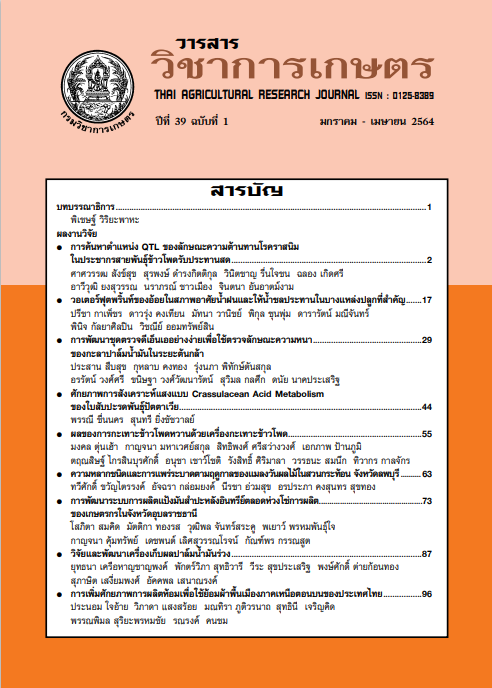วอเตอร์ฟุตพริ้นท์ของอ้อยในสภาพอาศัยน้ำฝนและให้น้ำชลประทานในบางแหล่งปลูกที่สำคัญ
DOI:
https://doi.org/10.14456/thaidoa-agres.2021.2คำสำคัญ:
sugarcane, อ้อยบทคัดย่อ
การผลิตอ้อยมีความจำเป็นต้องใช้น้ำในกระบวนการผลิตเป็นจำนวนมาก จากสถานการณ์การเปลี่ยนแปลงของสภาพภูมิอากาศรวมถึงพื้นที่ปลูกอ้อยเพิ่มมากขึ้น ทำให้มีการใช้น้ำสำหรับการผลิตอ้อยเพิ่มมากขึ้นด้วย จึงได้ประเมินค่าวอเตอร์ฟุตพริ้นท์ของอ้อยเพื่อการวางแผนการใช้นำ้ที่มีอยู่สำหรับการผลิตอ้อยอย่างมีประสิทธิภาพ ดำเนินการเก็บข้อมูลการผลิตอ้อยในสภาพการปลูกแบบอาศัยน้ำฝนจำนวน 119 แปลง และการปลูกแบบให้น้ำชลประทาน จำนวน 54 แปลง ในพื้นที่ปลูก 13 จังหวัด ที่เป็นแหล่งปลูกอ้อยที่สำคัญของประเทศไทย ระหว่างปี 2558-2560 บันทึกข้อมูลวันปลูก วันเก็บเกี่ยว การให้น้ำ การใส่ปุ๋ย ข้อมูลสภาพภูมิอากาศ และผลผลิต แล้วนำมาใช้คำนวนค่าวอเตอร์ฟุตพริ้นท์ตามคู่มือการประเมินร่องรอยการใช้น้ำ พบว่า ค่าวอเตอร์ฟุตพริ้นต์ของอ้อยใน
สภาพอาศัยน้ำฝนมีค่าเฉลี่ย 95.1 ลบ.ม./ตัน โดย เป็น WFGreen และ WFGrey จำนวน 69.6 และ 25.6 ลบ.ม./ตัน ตามลำดับ ส่วนสภาพให้น้ำชลประทานมีค่าเฉลี่ย 117.7 ลบ.ม./ตัน แยกเป็น WFGreen WFBlue และ WFGrey จำนวน 58.5 37.5 และ 21.7 ลบ.ม./ตัน ตามลำดับ การปลูกแบบให้นำ้ชลประทานทำให้วอเตอร์ฟุตพริ้นท์สีฟ้า (WFBlue) เพิ่มขึ้น 37.5ลบ.ม./ตัน แต่ผลผลิตเพิ่มขึ้นเพียง 1.4 ตัน/ไร่ ดังนั้น การพิจารณาการให้น้ำแก่อ้อยจึงต้องคำนึงถึงพันธุ์ที่ปลูก และให้น้ำในปริมาณที่เหมาะสม เพื่อให้การใช้น้ำสำหรับการผลิตอ้อยมีประสิทธิภาพมากขึ้น
เอกสารอ้างอิง
กอบเกียรติ ไพศาลเจริญ ทักษิณา ศันสยะวิชัย ศุภกาญจน์ ล้วนมณี ศรีสุดา ทิพยรักษ์ เกษม ชูสอน จินดารัตน์ ชื่นรุ่ง และชยันต์ ภักดีไทย. 2555. ความต้องการน้ำและค่าสัมประสิทธิ์การใช้น้ำของอ้อยพันธุ์ขอนแก่น 3. ว. แก่นเกษตร. 40 (พิเศษ 3): 103-114.
เจษฎา ภัทรเลอพงศ์. 2553. การศึกษาความสัมพันธ์ระหว่างอัตราการสังเคราะห์แสงด้วยแสงสุทธิและศักย์ของน้ำในใบอ้อยเพื่อหาค่าสอบเทียบแบบจำลองมวลชีวภาพของอ้อย. หน้า 58-95 ใน รายงานฉบับสมบูรณ์ โครงการสร้างองค์ความรู้และพัฒนาด้านอ้อยภายใต้แผนแม่บทโครงการสร้างพื้นฐานทางปัญญา โครงการระยะยาว ปี 2552: เล่มที่ 2 ด้านดิน น้ำและปุ๋ย. กรุงเทพฯ.
นิรนาม. 2554. คำนวณฝนใช้การ. คู่มือปฏิบัติงาน เล่มที่ 6/16. กรมชลประทาน. 27 หน้า.
นิรนาม. 2560. รายงานพื้นที่ปลูกอ้อย ปีการผลิต 2559/60. กลุ่มวิชาการและสารสนเทศอุตสาหกรรมอ้อยและน้ำตาลทราย สำนักนโยบายอุตสาหกรรมอ้อยและน้ำตาลทราย สำนักงานคณะกรรมการอ้อยและน้ำตาลทราย กรุงเทพฯ 127 หน้า.
นิรนาม. 2561. SDG6 การจัดการน้ำและสุขาภิบาล. แหล่งข้อมูล https://thailand.opendevelopmentmekong.net/th/topics/sdg-6-clean-water-and-sanitation สืบค้น: 18 กรกฎาคม 2563.
ปรีชา กาเพ็ชร ทักษิณา ศันสยะวิชัย กาญจนา กิระศักดิ์ และสุพัตตรา คณานิตย์. 2553. การตอบสนองของอ้อย (Sacharum offcinarum L.) พันธุ์ขอนแก่น 3 ต่ออัตราการให้น้ำในปริมาณจำกัด. ว.วิชาการเกษตร. 28 (3): 306-316.
สานิตย์ดา เตียวต๋อย ชลิตา สุวรรณ และ ธณัฏฐ์ยศ สมใจ. 2555. วอเตอร์ฟุตพริ้นต์ของอ้อยและมันสำปะหลังสำหรับการผลิตเอทานอลในภาคตะวันออก ประเทศไทย. ว.สมาคมวิศวกรรมเกษตรแห่งประเทศไทย. 18 (1): 69-75.
Allen R.G., L.S. Pereira, D. Raes, and M. Smith. 1998. Crop Evapotranspiration: Guidelines for Computing Crop Water Requirements-FAO Irrigation and Drainage. Paper 56. Food and Agriculture Organization of the United Nations, Rome. 300 p.
Chapagain A.K., A.Y. Hoekstra, H.H.G. Savenije, and R. Gautam. 2006. The Water Footprint of Cotton Consumption: an Assessment of the Impact of Worldwide Consumption of Cotton Products on the Water Resources in the Cotton Producing Countries. Ecol. Econ. 60: 186-203.
Gerbens-Leenes P.W. and A.Y. Hoekstra. 2012. The Water Footprint of Sweetners and Bio-ethanol. Env. Inter. 40 (2012) : 202-211.
Hoekstra A.Y., A.K. Chapagain, M.M. Aldaya, and M.M. Mekonnen. 2011. The Water Footprint Manual Setting the Global Standard. Earthscan Washington, DC. 228 p.
Jidapa K., S. Patcharin, and J. Nattawut. 2017. Growth and Physiological Patterns of Sugarcane Cultivars to Mimics Drought Conditions in Late Rainy Season System. Naresuan University. J. Sci. Tech. 25 (2): 102-112.
Khanittha C., K. Supasit, and D.C. Slack. 2017. Evaluation of the Water Footprint of Sugarcane in Eastern Thailand. Eng. J. 21 (5): 193-201.
Ratchayuda K. and S. Sate. 2012. Water Footprint of Bioethanol Production from Sugarcane in Thailand. J. Env. Earth Sci. 2(11) : 61-68.
Rattikarn K., and S. Sate. 2012. The Water Footprint of Sugarcane and Cassava in Northern Thailand. Procedia-Social and Behavioral Sci. 40 (2012): 451-460.
ดาวน์โหลด
เผยแพร่แล้ว
รูปแบบการอ้างอิง
ฉบับ
ประเภทบทความ
สัญญาอนุญาต
ลิขสิทธิ์ (c) 2021 วารสารวิชาการเกษตร

อนุญาตภายใต้เงื่อนไข Creative Commons Attribution-NonCommercial-NoDerivatives 4.0 International License.
วารสารวิชาการเกษตร



